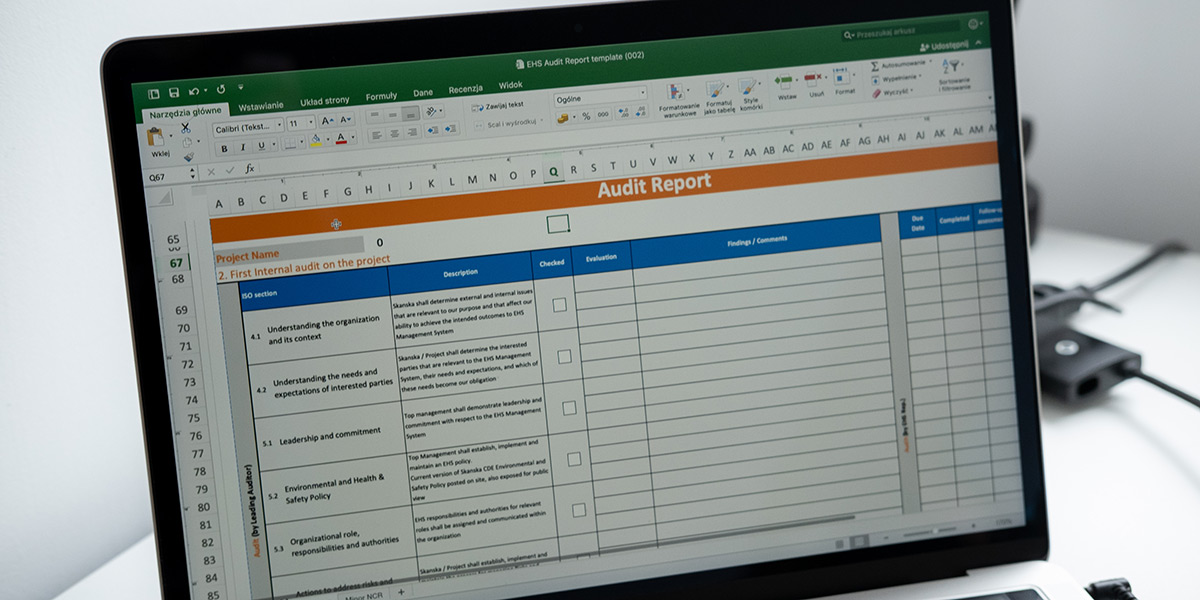How to effectively conduct inspections?
It’s hard to imagine a construction site functioning smoothly without inspections. Many aspects of work are checked daily to ensure high quality, safety for people, and the environment. How are inspections conducted? Let’s find out.

How does it look like now?
Companies that approach quality, safety, and environmental management on the construction site professionally prepare plans for each process. The plan consists of a set of one-time and cyclical inspections conducted at specified intervals and stages of work. It can be said that inspection is one of the most crucial tools on the construction site, with a tangible impact on the quality and safety of work. Therefore, I would like to take a closer look at this issue.
Whether we’re talking about controlling a specific aspect of work, inspecting an entire building, or a section of a road, the goal and method of inspection are similar. It’s about verifying the existing state according to a specified checklist. This definition sounds quite theoretical and synthetic, but how does it look in practice?
Inspections are conducted according to pre-prepared checklists, which are guidelines outlining how the inspection should be carried out. The basis for these guidelines can be building law regulations, standards, internal company standards, or best practices.
An expert creates a list of control elements based on their knowledge and experience. The checklist is often in the form of an Excel sheet, acting as a template and filled out during the inspection. After the inspection, an engineer or manager prepares a report, consisting of the completed checklist and a list of discrepancies or areas for improvement.
What happens next? The identified discrepancies are corrected within the specified timeframe, and the inspection is carried out again, with a particular focus on verifying the discrepancies.

Where is the problem?
It might seem like there’s nothing simpler than going through a checklist. The topic, however, only appears simple. Let’s consider a few issues:
- If the quality or safety plan is well-prepared, there are dozens of inspection templates. During the project, templates are modified, and new documents are created. In such circumstances, how can we ensure that the templates are up-to-date, consistent, and always accessible to the team?
- What if the inspection is conducted by someone who didn’t create the checklist but is a recent graduate in construction? Will they be able to handle this tool, and will their work be fully valuable?
- Regular inspections result in many reports of discrepancies, and resolving them can take from a few days to several months. Therefore, how can we monitor the impact of the inspection on the implementation of corrective works?
- What about efficiency and work comfort? Running around the construction site with a laptop and an open Excel sheet is neither convenient nor safe.
As you can see, the problems are quite complex and touch on various aspects of managing control on the construction site. How can we deal with these difficulties?

Photo by Wesley Tingey on Unsplash
What can we do?
The consistency and currency of documents and tools are a common issue in companies, not just in construction. However, in the construction industry, it reaches a large scale and simultaneously leads to significant financial consequences. It is essential for inspection templates to be prepared according to a specific convention so that an engineer doesn’t have to wonder each time what to enter or mark where.
Moreover, templates should be available in one place for every team member, always at hand on both the computer and the phone. It’s a good practice to add a description or reference to a commonly used pattern to the inspection template, clearly defining the requirements for the controlled work area. Additionally, it’s very helpful, especially for young engineers, to provide a description or guidance on the controlled element.
This way, a young engineer can quickly acquire knowledge in the required area, prepare in advance, and conduct the inspection more comfortably and substantively. This simple practice adds significant value to the entire company: the onboarding process for new employees is shorter, the promotion of company practices and standards proceeds much faster.
When discrepancies are reported during inspections, they are most often noted ‘somewhere nearby,’ requiring switching between tools, sheets, phones, and computers. Undoubtedly, this complicates the inspection process itself. In the Hustro mobile application, there is the possibility of quickly registering discrepancies without leaving the context of the inspection. At the same time, the reported discrepancy is linked to a specific controlled element and the entire inspection. This allows us to monitor the status of discrepancies in real-time without dedicating additional time to it.
When discrepancies are reported during inspections, they are most often noted ‘somewhere nearby,’ requiring switching between tools, sheets, phones, and computers. Undoubtedly, this complicates the inspection process itself. In the Hustro mobile application, there is the possibility of quickly registering discrepancies without leaving the context of the inspection. At the same time, the reported discrepancy is linked to a specific controlled element and the entire inspection. This allows us to monitor the status of discrepancies in real-time without dedicating additional time to it.
Where is the value?
Let’s see what real benefits the application offers. Based on statistical data and interviews with representatives of companies using the Hustro application, we can present the following calculation.
| Inspection costs | Traditional Method | With Hustro |
| Average time of inspection (1) | 3 h | 1,5 h |
| Number of inspections per month (2) | 8 | 8 |
| Time devoted to conducting inspections | 24 h | 12 h |
| Hourly rate of the inspector (PLN) | € 15 | € 15 |
| Time spent on preparing reports in a month | 3 | 3 |
| Total cost | € 1,065 | € 532.80 |
| Lower costs | 100% less |
| Costs of implementing an inspector | Traditional Method | With Hustro |
| Introduction of a new employee by a supervisor (3) | 20 h / month | 5 h / month |
| Inspector’s hourly rate | € 15 | € 15 |
| Implementation period for a new employee | 3 months | 3 months |
| Time spent on preparing a weekly report | € 888 | € 222 |
| Lower costs | 400% less |
- (1) Average inspection time – taking into account that inspections cover a wide range of work areas, the values are based on interviews with users of the Hustro application.
- (2) Number of inspections per month – we assume that this is the average number of inspections conducted as part of various quality, safety, and environmental processes.
- (3) Introduction of a new employee by a supervisor – we assume that a young employee needs less time from a supervisor if they have access to well-prepared inspection templates that are suitable for self-development. Therefore, this requires less involvement from the supervisor.
Benefits
€ 532.95
lower monthly inspection cost
100 %
lower monthly inspection costs
€ 666.17
lower cost of implementing a new inspector
400%
less time and money spent on implementing a new inspector
Summary
Introduction of modern tools for creating templates and conducting inspections brings significant savings even on a small project (3 engineers/inspectors). The benefits can be divided into quantifiable ones, such as lower costs, and non-quantifiable ones, such as work comfort and document consistency. Therefore, is it worth delaying the introduction of modern tools to the construction site? This question should be answered by the construction industry manager themselves

Autor
Andrzej Bogatko
CO-FOUNDER. DESIGNER
Let’s talk about implementing the application in your company!
Related articles
Property handover – how to conduct it more efficiently?
Leaky windows, wall deformations, scratches on sills, plaster cracks... These are just a few of the many defects reported by customers during handovers, the most intense stage of construction project implementation. General contractors are bombarded with reports,...
How to implement applications on a construction site?
Implementing new technologies in a company is always a significant challenge. The digitization of processes is a change that may be met with resistance from the team. The mere introduction of 'change' is often unwelcome. In light of this, what should be done to make...
Can reporting be simpler?
Did you study construction? Certainly, it was an inspiring period. New acquaintances, a wealth of knowledge, first internships, stepping onto the construction site... Perhaps construction even became your passion. What has changed since then? Your professional career...
SOLUTIONS FOR
App for Investors and Developers
App for General Contractors
App for Investment Supervision
App for Installation and Engineering Companies
App for Property Owners and Managers
MODULES
Observations, defects and incidents
Inspections, reviews and walkthroughs
Analytics and Reporting
Document Management
PURCHASE
Book a Demo
Pricing
SUPPORT
Log in
ABOUT US
Company
References
People
Contact
European Union
Privacy Policy



